CEED 2025 Question paper with answer key pdf conducted on January 19, 2025 is available for download. The exam was successfully organized by IIT Bombay. In terms of difficulty level, CEED 2025 was considered easy. The question paper comprised a total of 49 questions divided among 4 sections.
CEED 2025 Question Paper with Answer Key PDF
| CEED 2025 Question Paper with Answer Key | Check Solutions |
CEED 2025 Solution
Question 1:
The words given below are written using a particular font. Identify the digit that does not belong to the same font.
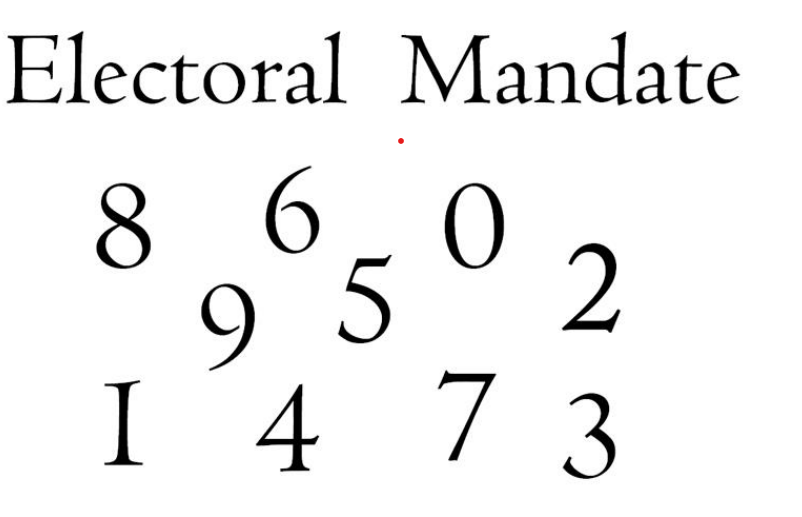
View Solution
The problem asks us to identify the digit that does not belong to the same font as the others.
- Observe the font style used in the text and digits.
- All digits except 2 match the font style of the text above.
Conclusion: The digit 2 does not belong to the same font as the others.
Question 2:
Shown below is a cross-section which is revolved 270 degrees around the P-Q axis to create a solid. How many surfaces will the resultant solid have?
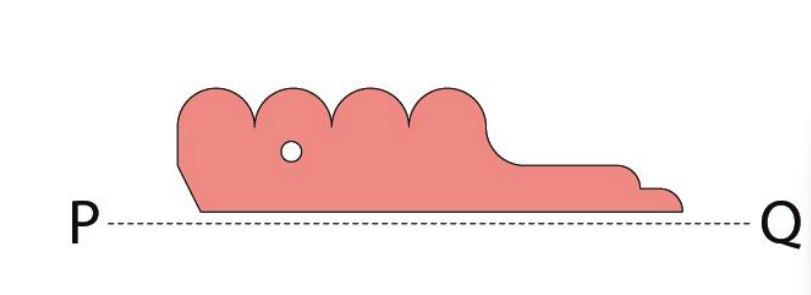
View Solution
To solve, consider the geometry of the cross-section:
- Count outer curved surfaces.
- Identify flat and cylindrical surfaces.
Total surfaces = 10. This includes curved, flat, and cylindrical surfaces.
Question 3:
Shown below is a strip of paper which is folded multiple times. How many red pawns are placed on the same side of the paper as the blue pawn?
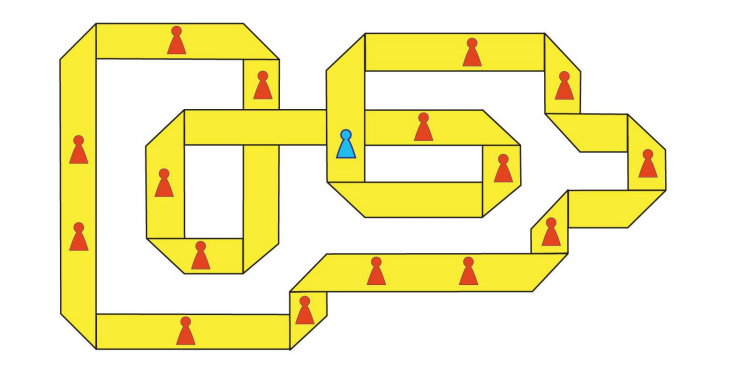
View Solution
Analyze the pattern of folding:
- Blue pawn is on a specific side.
- Count red pawns on the same side by observing the alternating folding pattern.
Conclusion: 9 red pawns are on the same side as the blue pawn.
Question 4:
Shown below is an image of multiple footwear items. How many complete pairs are there?
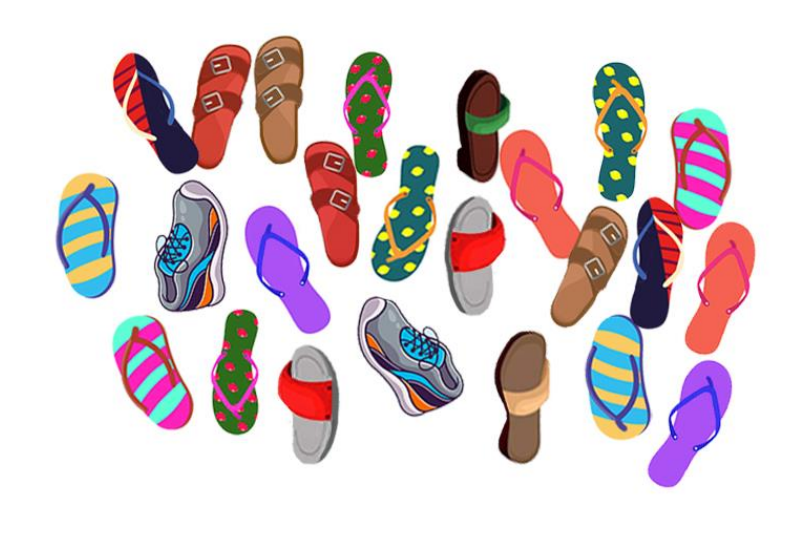
View Solution
Step 1: Examine the image closely and identify each footwear item.
Step 2: Pair each left and right footwear item that matches in design. Count the pairs carefully to ensure no unmatched items.
Step 3: After counting the matching pairs, there are 11 complete pairs of footwear.
Question 5:
Shown below is a configuration of an isosceles triangle sliced into eight parts, each of the same height. While the first and last parts of the triangle remain fixed, the remaining parts have been displaced horizontally, by multiples of 0.5 cm. What is the area of the grey portion?
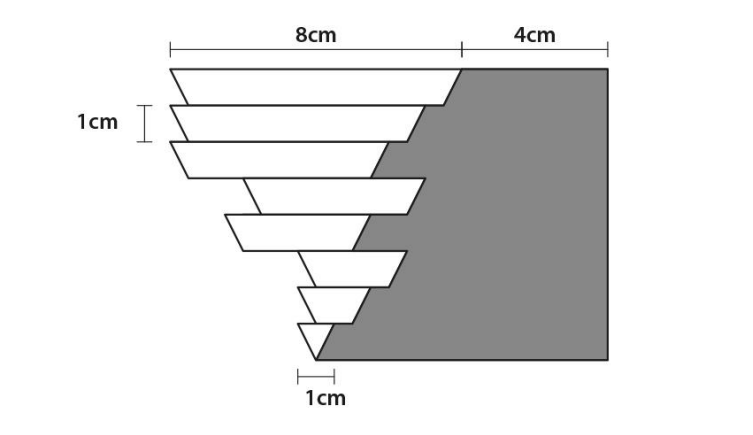
View Solution
Step 1: The total height of the triangle is \(h = 16 \, \text{cm}\), and its base \(b = 8 \, \text{cm}\).
Step 2: Original area of the triangle:
\(A_{\text{triangle}} = \frac{1}{2} \times 8 \times 16 = 64 \, \text{cm}^2.\)
Step 3: After subtracting the displaced areas, the remaining grey portion is \(48 \, \text{cm}^2\).
Question 6:
Shown below is an arrangement of closely stacked spheres. Assume each one to be in contact with its immediate neighbor. What is the total number of points where the spheres touch each other?
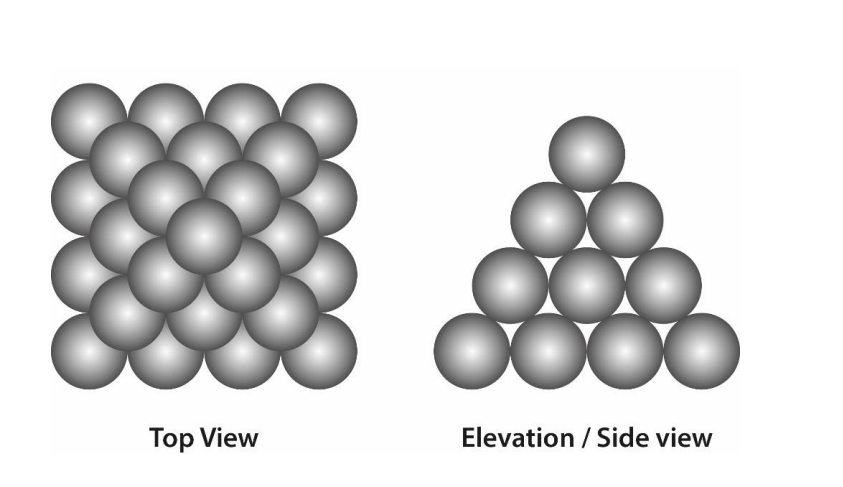
View Solution
Step 1: In a closely stacked arrangement, each sphere touches several others.
Step 2: Examine the triangular pattern of stacking and calculate the contact points.
Step 3: Total contact points = 96.
Question 7:
Shown below are three perspective views of a solid object. How many surfaces does the object have? Assume hidden surfaces to be flat.

View Solution
Step 1: Observe the visible surfaces in the given views.
Step 2: Identify hidden surfaces based on the geometry of the object.
Step 3: Count all the surfaces (visible + hidden) to find a total of 30.
Question 8:
A monospaced font is a font in which all characters are exactly of the same width. A document uses a monospaced font for typesetting where each character is exactly 0.6 cm wide. A text line in this document contains only 10 words, where each word contains 6 characters. What is the length of the line in cm?
View Solution
Step 1: Each word consists of 6 characters, and there are 10 words. Each character and space is 0.6 cm wide.
Step 2: Total width of characters:
\(10 \, \text{words} \times 6 \, \text{characters per word} \times 0.6 \, \text{cm} = 36 \, \text{cm}.\)
Step 3: Total width of spaces:
\(9 \, \text{spaces} \times 0.6 \, \text{cm} = 5.4 \, \text{cm}.\)
Conclusion: Total length = \(36 + 5.4 = 41.4 \, \text{cm}\).
Question 9:
Shown below are perspective views of a hexagonal prism, a cube, and a cylinder, all having height 10 cm. If the objects are cut by straight planes to generate various cross-sections, which of the statements is/are TRUE?
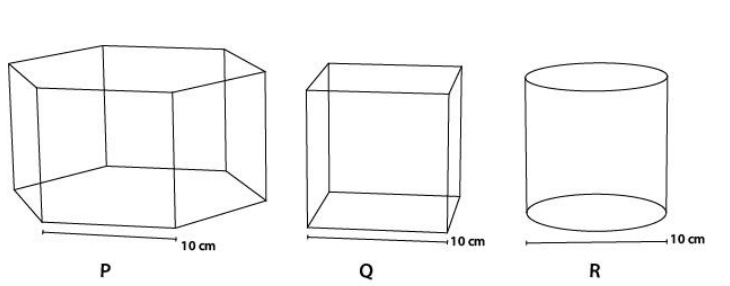
View Solution
Step 1: Analyze each object for possible cross-sections:
- P: Hexagonal prism can reveal hexagonal, rectangular, and triangular cross-sections.
- Q: Cube can reveal square and rectangular cross-sections.
- R: Cylinder can reveal curvilinear sections and square cross-sections.
Conclusion: The statements (A), (B), and (C) are correct.
Question 10:
Shown below is the front and top views of an object. Which of the options can be the CORRECT object?
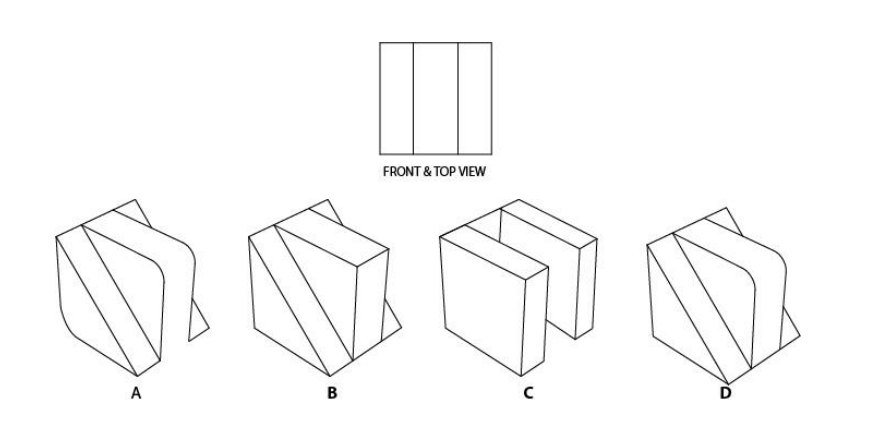
View Solution
Step 1: Match the dimensions and angles from the front and top views with the given options.
Step 2: Option B and D align with both views and are therefore correct.
Question 11:
Shown below is a graph showing the journey of a hero in a 60-minute movie. This graph represents the relationship between time and events in the hero’s journey. Which of the statements is/are TRUE?
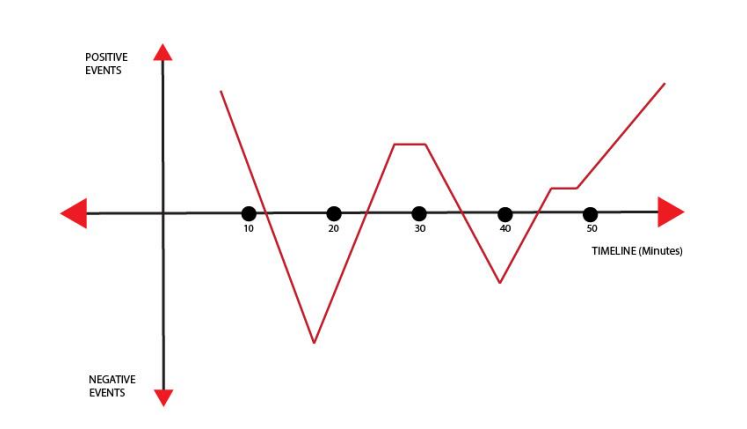
View Solution
Step 1: Identify trends in the graph:
- The upward spike towards the end suggests the hero defeats the villain (A).
- A dip between the 12th and 18th minute indicates a negative event, possibly an accident (D).
Conclusion: The correct statements are (A) and (D).
Question 12:
Shown on the left is the image of an unfolded cube. Which of the options represent(s) the folded cube?
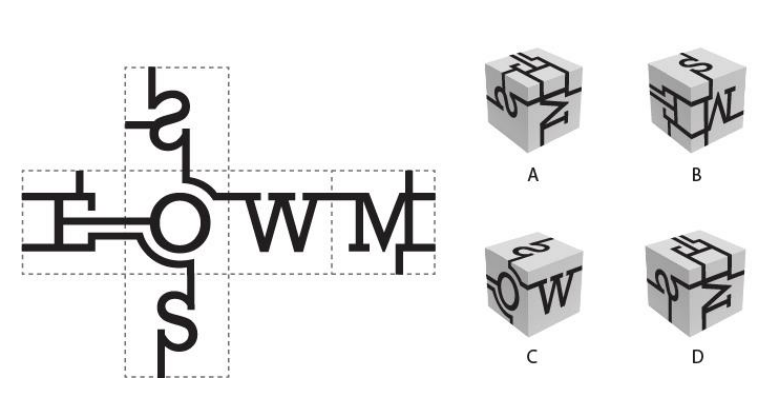
View Solution
Step 1: Examine the net and identify how it folds into a cube.
Step 2: Options A and B align with the net when folded, showing correct positioning of faces.
Question 13:
The figures shown below depict four mechanisms made using links and hinges, where the small circles represent hinges. Which of the options will allow relative motions between the links?
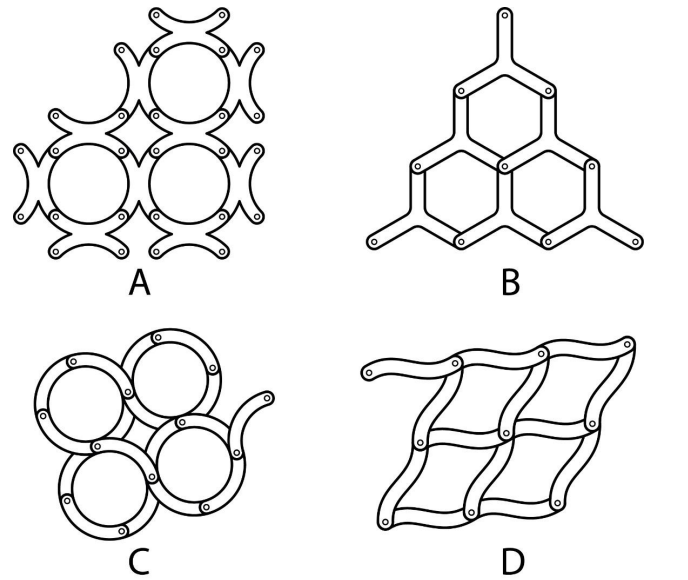
View Solution
Step 1: Links connected with hinges allow relative motion, depending on the degree of freedom provided.
Step 2: Options A, C, and D have configurations allowing such motion.
Question 14:
Shown below are images of chairs produced using typical manufacturing processes. Which of the following statements is/are TRUE?
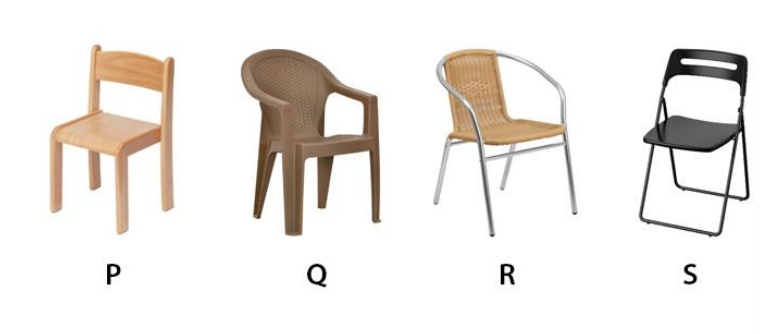
View Solution
Step 1: Observe the designs:
- P is stackable; R requires complex manufacturing.
- Q is made of molded plastic, indicating complex processes.
Conclusion: Statements (A) and (C) are correct.
Question 15:
Shown below are four different types of scissors. Which of the following statements is/are TRUE?
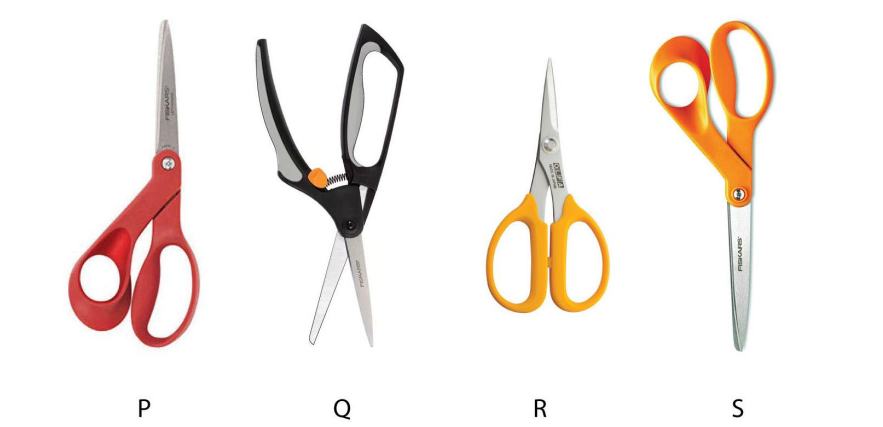
View Solution
Step 1: P and S are designed for right- and left-handed users respectively, based on handle positioning.
Step 2: Q is spring-loaded for minimal effort, and R is reversible for right- and left-handed use.
Conclusion: The correct answers are (B) and (C).
Question 16:
Shown on the left are three tiles. Which option(s) can be made using only these tiles? Rotations of tiles are allowed.

View Solution
Step 1: By rotating the tiles, options B and D can be formed.
Step 2: Options A and C cannot be formed due to shape or arrangement limitations.
Conclusion: The correct answers are (B) and (D).
Question 17:
Shown below are images of four different models of dispensers. Which of the statements is/are TRUE?
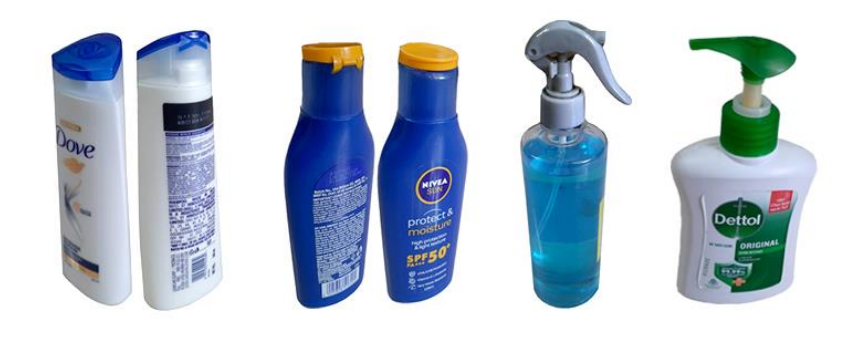
View Solution
Step 1: Models with valves and hinges are identified.
Step 2: At least one model uses pressure, and another uses the lever principle.
Conclusion: The correct answers are (A) and (D).
Question 18:
Shown below is an empty triangle which is to be filled using five tiles. Which option(s) will exactly fill this triangle when all tiles are used? Scaling, Repeating, and Flipping of tiles is not allowed; while rotation is allowed.
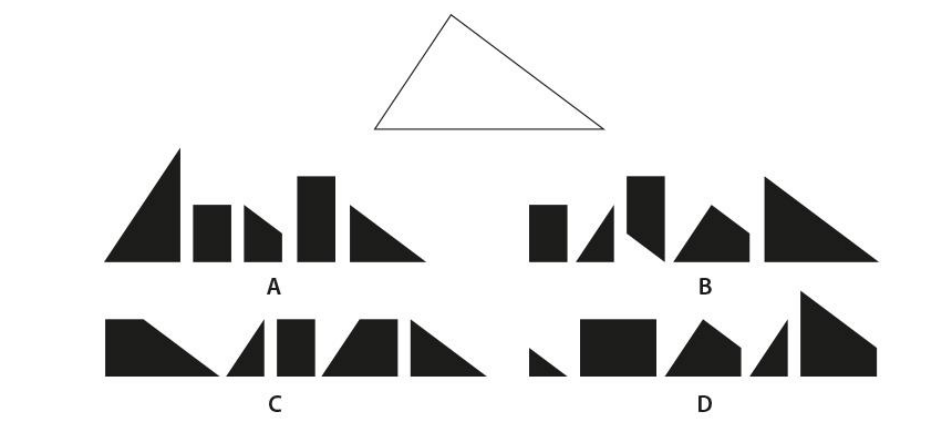
View Solution
Step 1: Tiles are rotated to fit perfectly into the triangle for options C and D.
Step 2: Options A and B leave gaps or exceed boundaries.
Conclusion: The correct answers are (C) and (D).
Question 19:
Shown below are words in a particular font. Which option belongs to the same font?
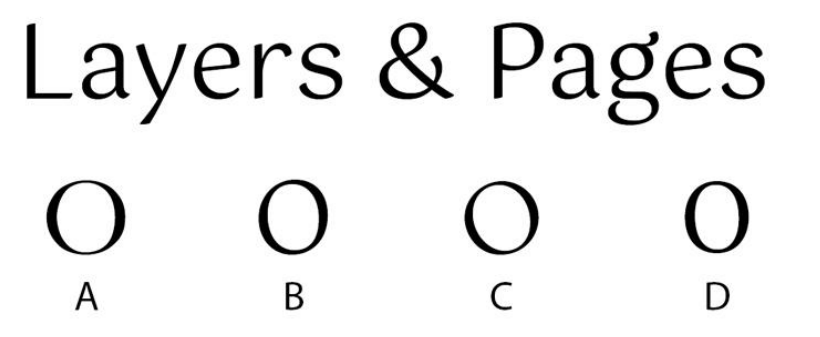
View Solution
Step 1: Observe font characteristics, such as curves, thickness, and spacing.
Step 2: Option B matches the given font style.
Conclusion: The correct answer is (B).
Question 20:
Shown on the left is an animation loop of a mouse moving. Which option shows the CORRECT path of the mouse?
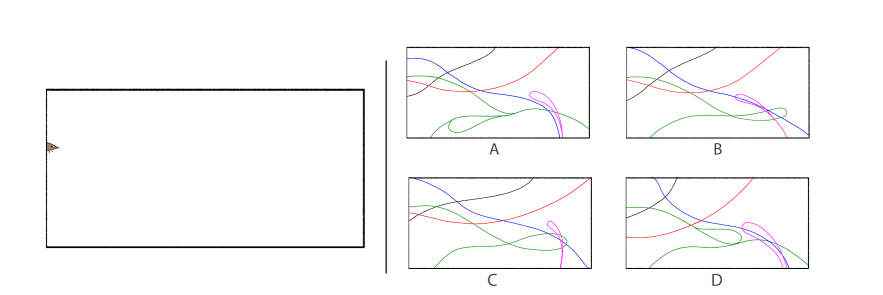
View Solution
Step 1: Trace the mouse's path in the animation loop.
Step 2: Compare each option with the observed movement path.
Conclusion: Option B matches the animation's path.
Question 21:
Which option is a simple rotation of the image given below?
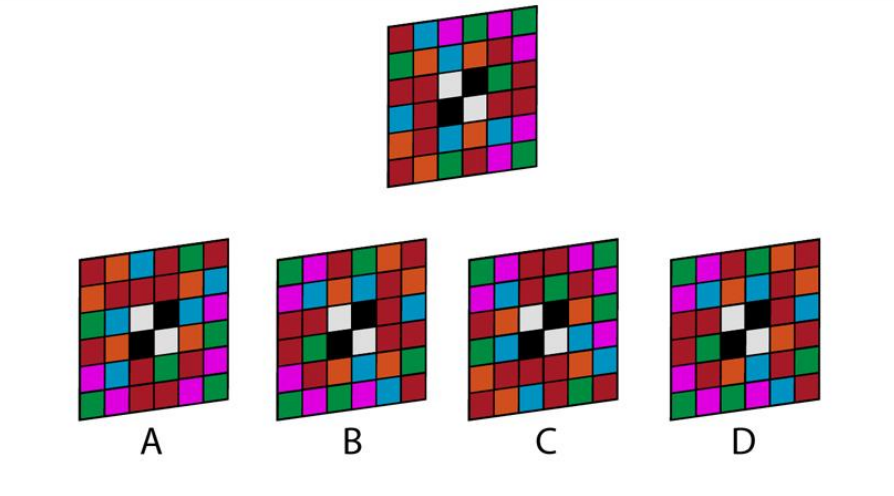

View Solution
Step 1: Analyze the image and observe its pattern.
Step 2: Consider each option as a rotation. Option B is a simple rotation of the original image.
Conclusion: The correct answer is Option B.
Question 22:
Which option will replace the question mark?
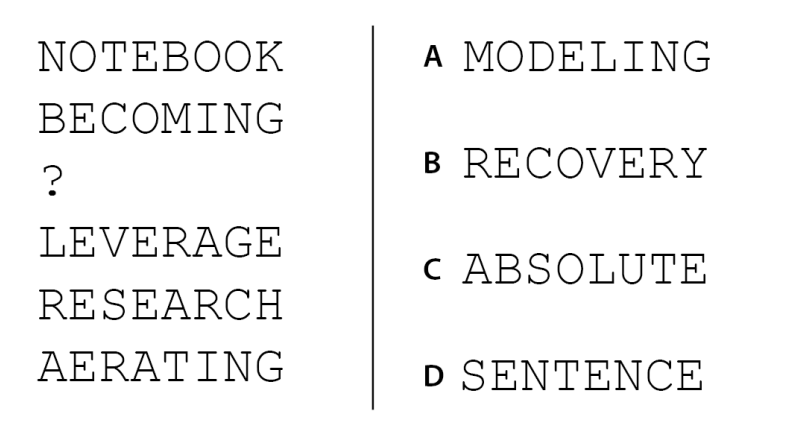
View Solution
Step 1: Observe the letter pattern. The letters in each word are arranged in alphabetical order.
Step 2: The word "Modeling" fits as the next word in the sequence.
Conclusion: The correct answer is (A).
Question 23:
Shown below is a wooden artifact made using traditional materials and processes. Which option shows the relevant operations involved in its making, not necessarily in the production sequence?
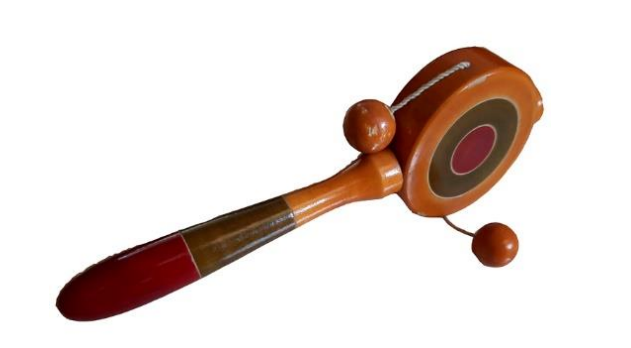
View Solution
Step 1: Observe the steps like chiseling, turning, and lacquering typically used in woodwork.
Step 2: Option B reflects the standard process.
Conclusion: The correct answer is (B).
Question 24:
Shown below is the perspective view of an object when viewed from the direction of the arrow. The object undergoes sequential rotations. Which option shows the CORRECT resultant view?
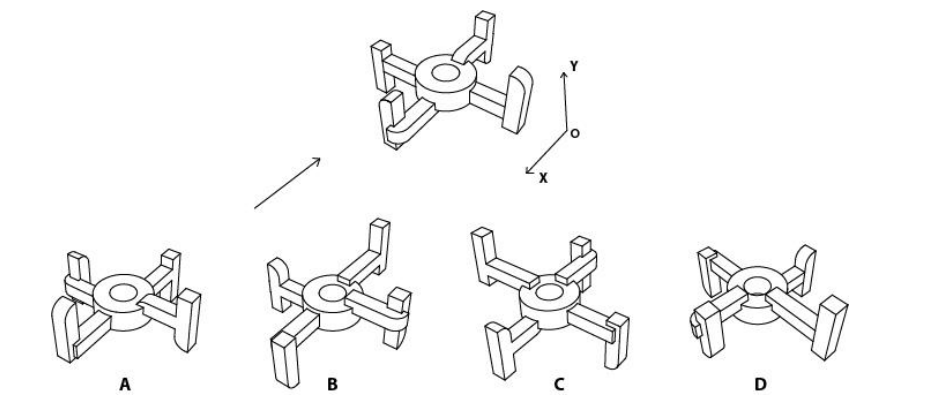
View Solution
Step 1: Apply the 90-degree clockwise rotation about the y-axis.
Step 2: Apply the 180-degree anti-clockwise rotation about the x-axis.
Step 3: Apply the 90-degree anti-clockwise rotation about the y-axis.
Conclusion: The correct answer is (C).
Question 25:
Shown below is an image that shows the step-by-step process of folding a white-colored fabric. The folded fabric is dipped into color at three corners P, Q, and R as indicated in the image. What will be the resultant fabric after unfolding?
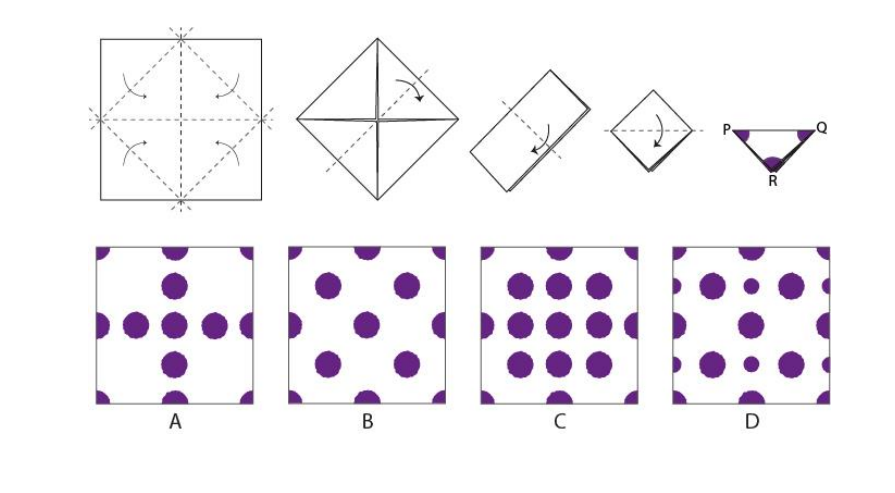
View Solution
Step 1: Follow the sequence of folding and color application at corners P, Q, and R.
Step 2: After unfolding, the pattern matches with Option B.
Conclusion: The correct answer is (B).
Question 26:
Which arrangement of tiles will create the image shown on the left? Tiles can be rotated but not flipped.
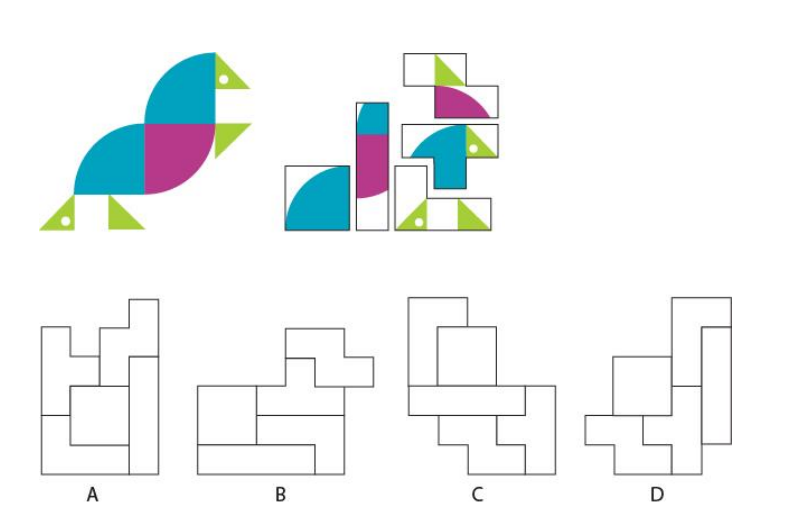
View Solution
Step 1: Visualize the arrangement and possible rotations of the tiles to fit the given pattern.
Step 2: Option (C) is the correct arrangement where all tiles fit perfectly to form the required pattern.
Question 27:
Which option will replace the question mark?
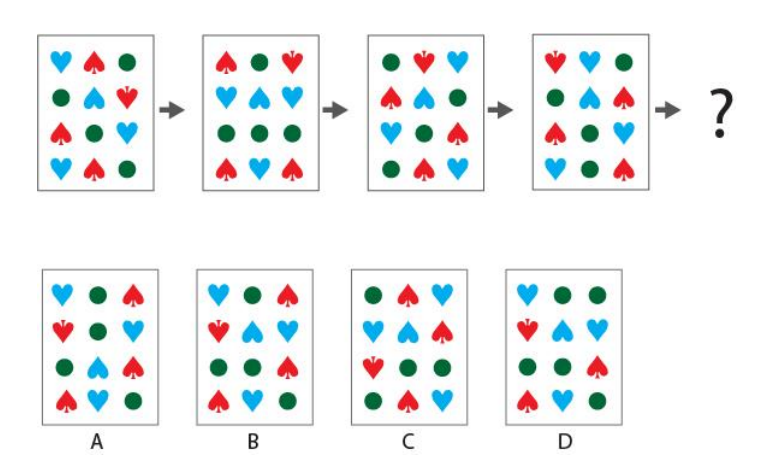
View Solution
Step 1: Observe the sequence and analyze how the pattern evolves.
Step 2: Option B completes the sequence based on the alternation and positioning of elements.
Question 28:
Which option will replace the question mark?
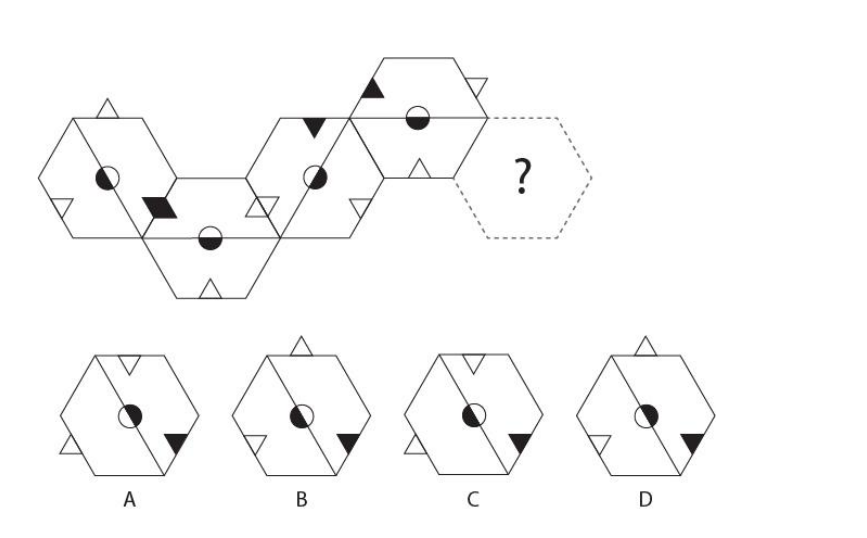
View Solution
Step 1: Analyze the hexagonal shapes and their geometric alignment.
Step 2: Option B continues the sequence by maintaining the rotational and translational symmetry.
Question 29:
A circular disc and a sphere of the same diameter are floating above the ground. The circular disc is parallel to the ground. Which option shows the CORRECT set of shadows on the ground when seen from the top?
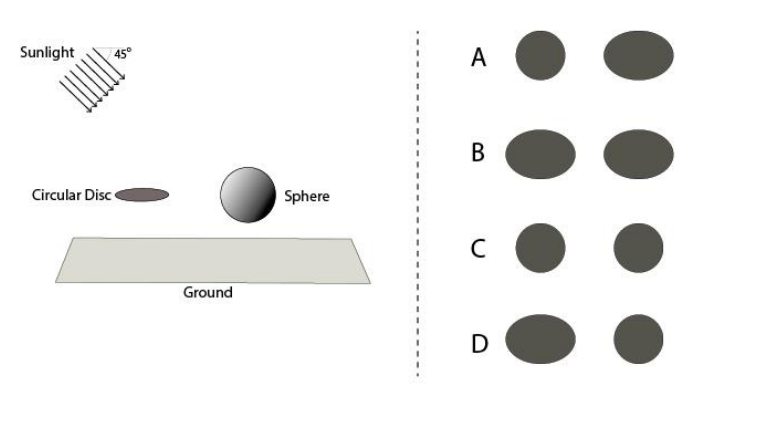
View Solution
Step 1: A circular disc parallel to the ground casts a circular shadow.
Step 2: The sphere casts an elliptical shadow due to the angled sunlight.
Step 3: Option (A) correctly represents both shadows.
Question 30:
Shown on the left is an image. Which option is the correct profile of the image?
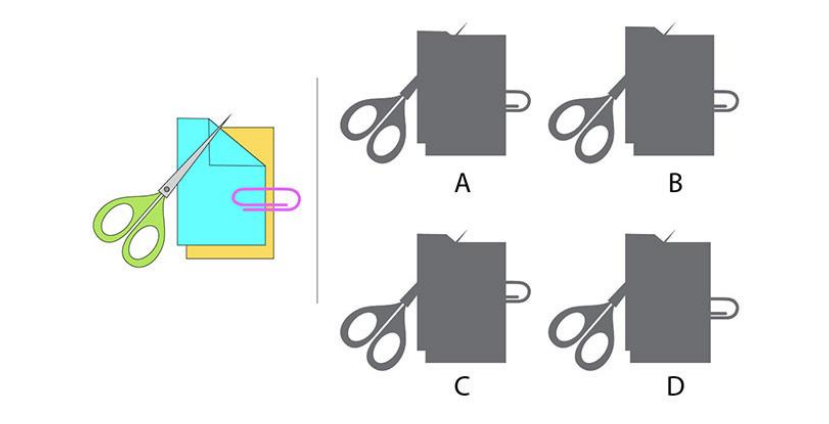
View Solution
Step 1: Analyze the image and identify the objects' alignment.
Step 2: Option (B) accurately depicts the profile view of scissors cutting the paper.
Question 31:
Which option is the mirror image of the sentence shown on the left?

View Solution
Step 1: The mirror image involves reversing the order of the letters horizontally.
Step 2: In option (B), the text is reversed correctly to form the mirror image of the original sentence.
Step 3: Options (A), (C), and (D) do not produce the correct mirror image, as the text is not reversed properly.
Question 32:
Shown below is an artistic representation of various dance forms of India. Which option shows the correct sequence of the dance forms?
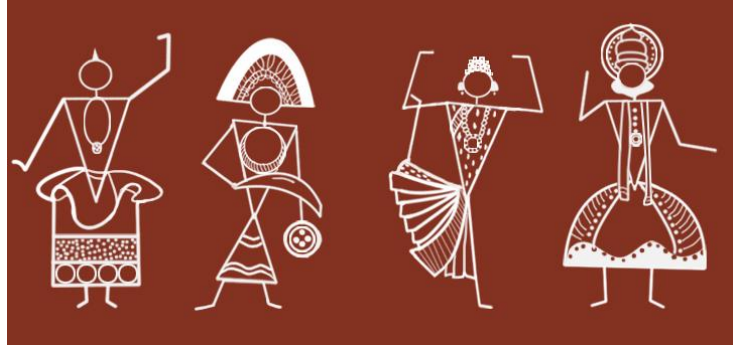
View Solution
Step 1: The image displays different Indian dance forms, each identifiable by posture, attire, and gestures.
Step 2: Option (D) correctly matches the sequence of Manipuri, Chhau, Bharatanatyam, and Kathakali by analyzing the distinct characteristics of each dance form.
Step 3: Other options show incorrect sequences or mismatched postures.
Question 33:
Shown below is an image printed on a transparent sheet. If this sheet is folded along the dotted line, then which option will be the resultant view?
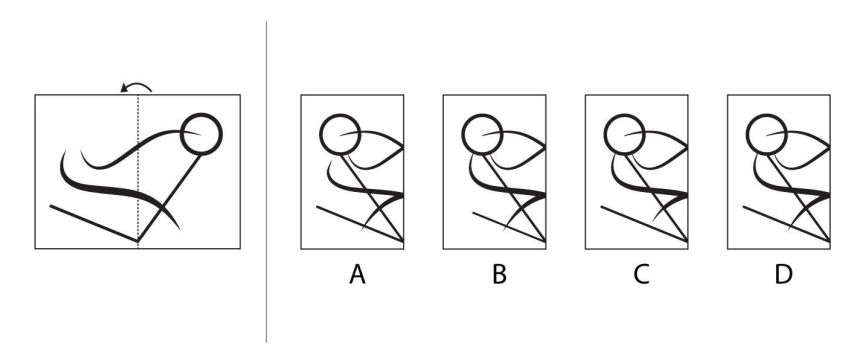
View Solution
Step 1: Visualize how the image will appear after folding along the dotted line. The fold will cause the left and right portions of the design to overlap.
Step 2: In option (D), the image correctly reflects the result after the sheet is folded along the dotted line.
Step 3: Other options do not match the correct result of the folding process.
Question 34:
Shown below are the key frames of a character lifting a sack. Which option will replace the question mark?
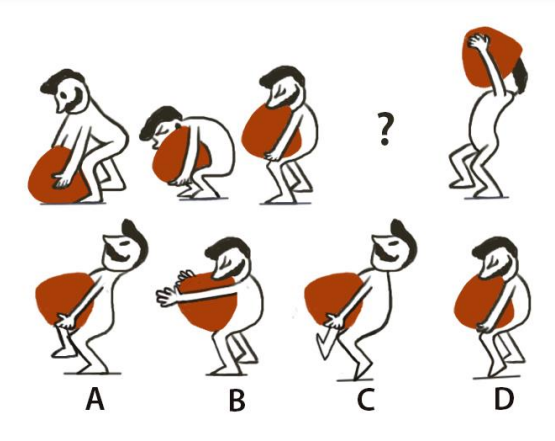
View Solution
Step 1: Analyze the motion of the character lifting the sack. The frames show the progression from bending to lifting the sack to the chest.
Step 2: The character should be in a stance where the sack is closer to the chest after bending down.
Step 3: Option A correctly depicts the sack's position, close to the chest in the correct stance.
Question 35:
Shown below is an animation of a bird flying. Which frame is NOT present in the animation?
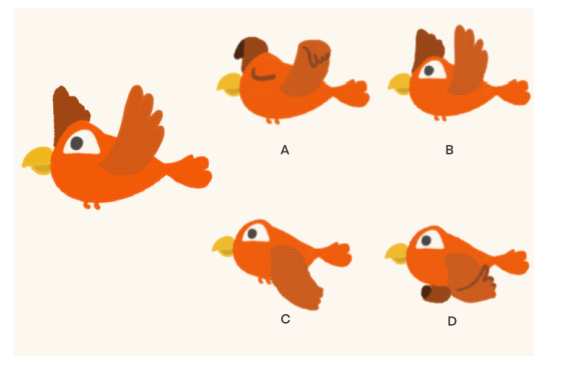
View Solution
Step 1: Observe the bird's wing movement in the animation frames. The bird flaps its wings alternately with smooth transitions.
Step 2: Each option shows a potential frame, but option (C) depicts an unrealistic wing position that does not match the natural movement.
Step 3: Therefore, frame (C) does not belong in the sequence.
Question 36:
A colour image is shown on the left. If the blue sky is painted black and the leaves are painted white, which is the CORRECT black and white image among the scaled options shown on the right?
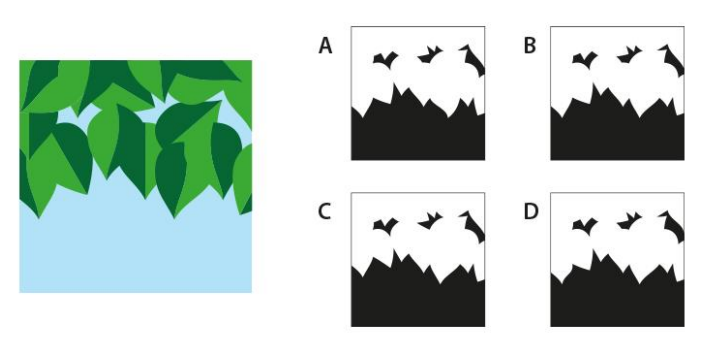
View Solution
Step 1: Identify the original colours in the image. Blue for the sky will become black, and green for the leaves will become white.
Step 2: After applying these transformations, compare the options to identify the one that matches the description.
Step 3: Option B is the correct transformation of the original image.
Question 37:
Shown below are frames from a film sequence that follow the 180-degree rule in cinematography. Which option will replace the question mark?
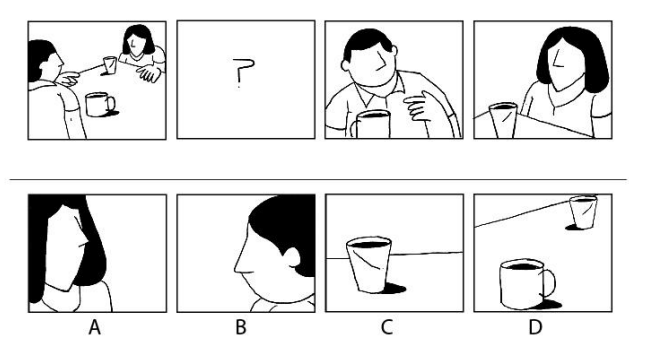
View Solution
Step 1: The 180-degree rule ensures the camera stays on one side of the scene to maintain spatial orientation.
Step 2: Analyze the frames and choose the one that maintains consistency in the character's relative positioning.
Step 3: Option D is the frame that follows the 180-degree rule correctly.
Question 38:
Shown below on the left are two views of a bent wire. Which option is the top view of the wire?
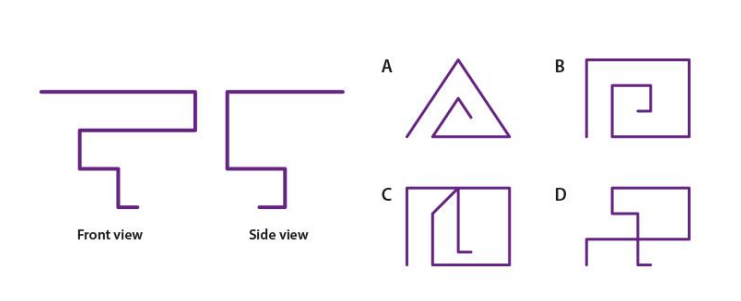
View Solution
Step 1: Visualize the given front and side views to mentally reconstruct the wire's shape.
Step 2: Compare the options to identify the correct top view that aligns with the given views.
Step 3: Option A correctly represents the top view.
Question 39:
Shown on the left is a set of equations. Which option belongs to the same set?
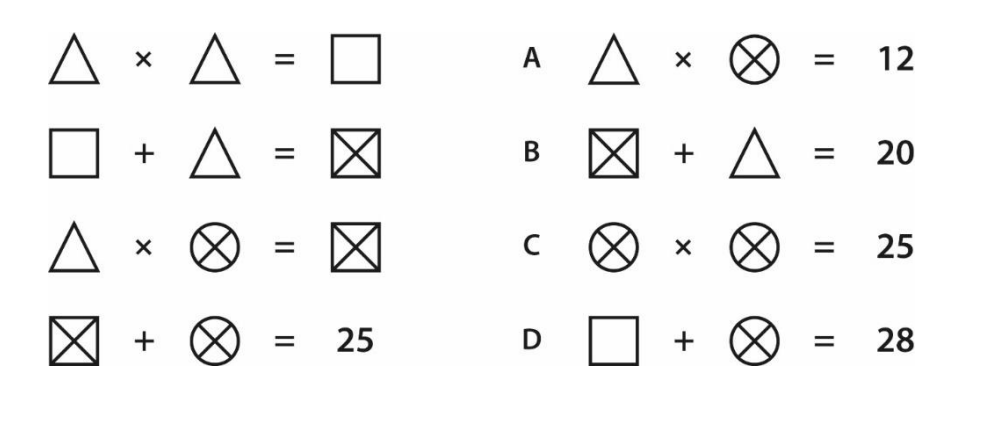
View Solution
Step 1: Identify the relationship between the symbols and their operations in the given equations.
Step 2: Apply the same operations to the options and check for consistency with the original pattern.
Step 3: Option C follows the same symbolic relationships and is the correct answer.
Question 40:
A sheet of paper is folded along the white dotted lines and then cut along black dotted lines as depicted below. Out of the four scaled-down options, which is the CORRECT resultant unfolded paper?
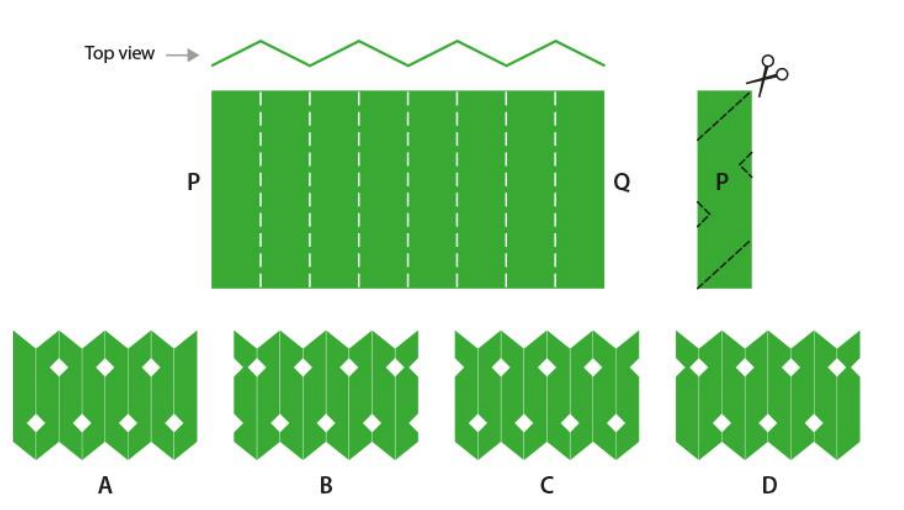
View Solution
Step 1: Visualize the sequence of folding and cutting, and how these operations affect the unfolded pattern.
Step 2: Compare the unfolded result with the given options to find the matching pattern.
Step 3: Option C correctly represents the resultant unfolded paper.
Question 41:
A square pyramid sequentially passes through three cut-outs, namely, 1, 2, and 3, without changing its orientation. Each cut-out has a circle with notches as shown. The cut-outs scrape off parts of the pyramid as it passes through them. Which option shows the CORRECT Side View of the remaining part of the pyramid at the end of the sequence?
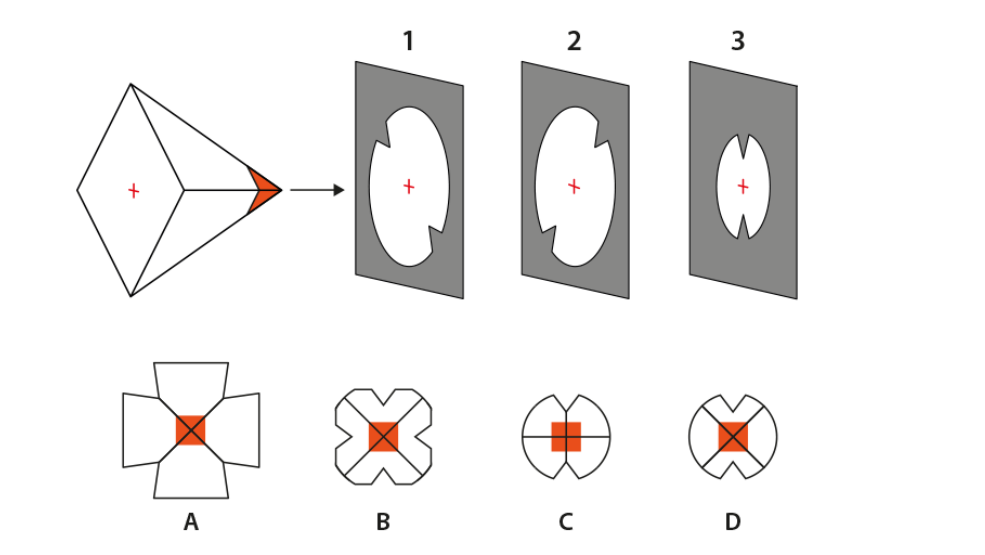
View Solution
Step 1: The pyramid passes through the cut-outs, scraping off specific sections of its geometry.
Step 2: The side view changes as the cut-outs remove parts of the shape.
Step 3: Option (C) accurately shows the remaining shape after passing through all cut-outs.
Question 42:
Shown below is a configuration of a circle and a rigid rod. The length of the rod PQ is equal to the circumference of the green circle. The rod tangentially revolves around the circle till point Q reaches point P. Which option represents the CORRECT tracing of point Q?
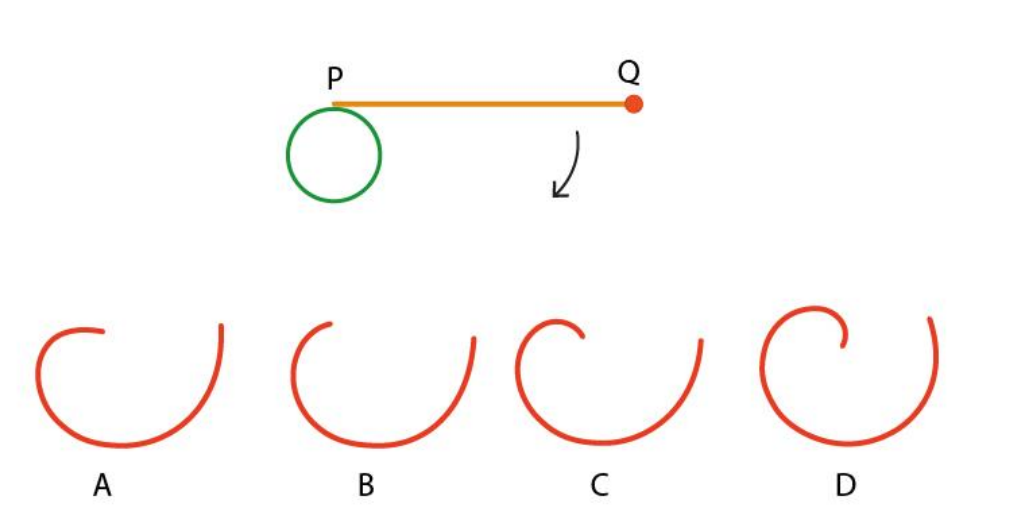
View Solution
Step 1: The rod moves tangentially along the circle, tracing a specific path.
Step 2: Point Q traces a curve corresponding to the motion of the rod around the circle.
Step 3: Option (C) matches the path traced by point Q correctly.
Question 43:
When “See you Bye” is spoken, which option shows the correct sequence of lip movement?
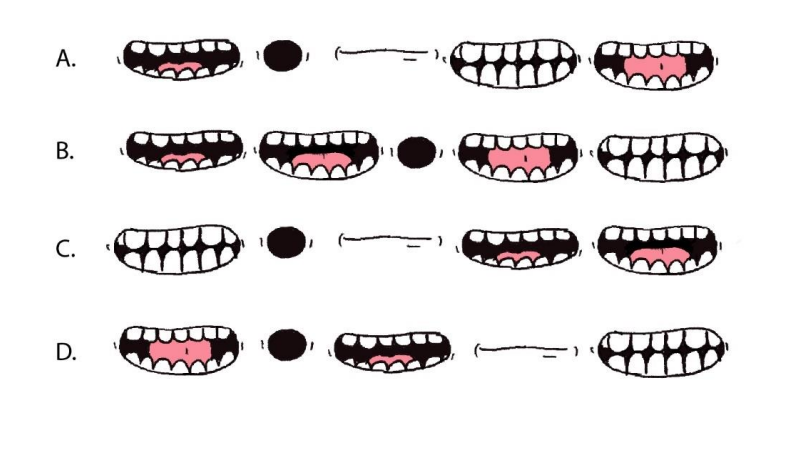
View Solution
Step 1: Analyze the lip movements for each word in the phrase “See you Bye.”
Step 2: Match the sequence of movements with the options provided.
Step 3: Option (C) shows the correct sequence of lip movements for the phrase.
Question 44:
Which option has all four parts that belong to the disc shown on the left?
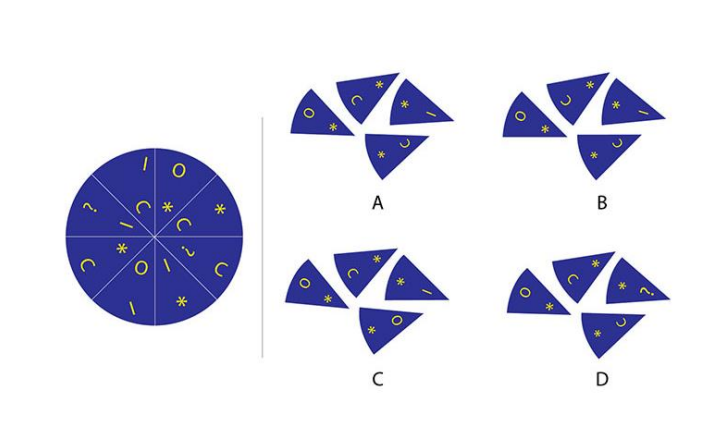
View Solution
Step 1: Examine the division of the disc into parts.
Step 2: Identify which option contains all parts of the original disc.
Step 3: Option (A) correctly includes all parts from the disc.
Sketching: Mandatory Question
Two kids, Kaa and Kii, are on an adventure trip in a forest. While exploring, suddenly a bear emerges and starts chasing them. The kids start running in panic through the forest. A fox is watching the whole scene. Sketch this scene from the fox’s point of view.
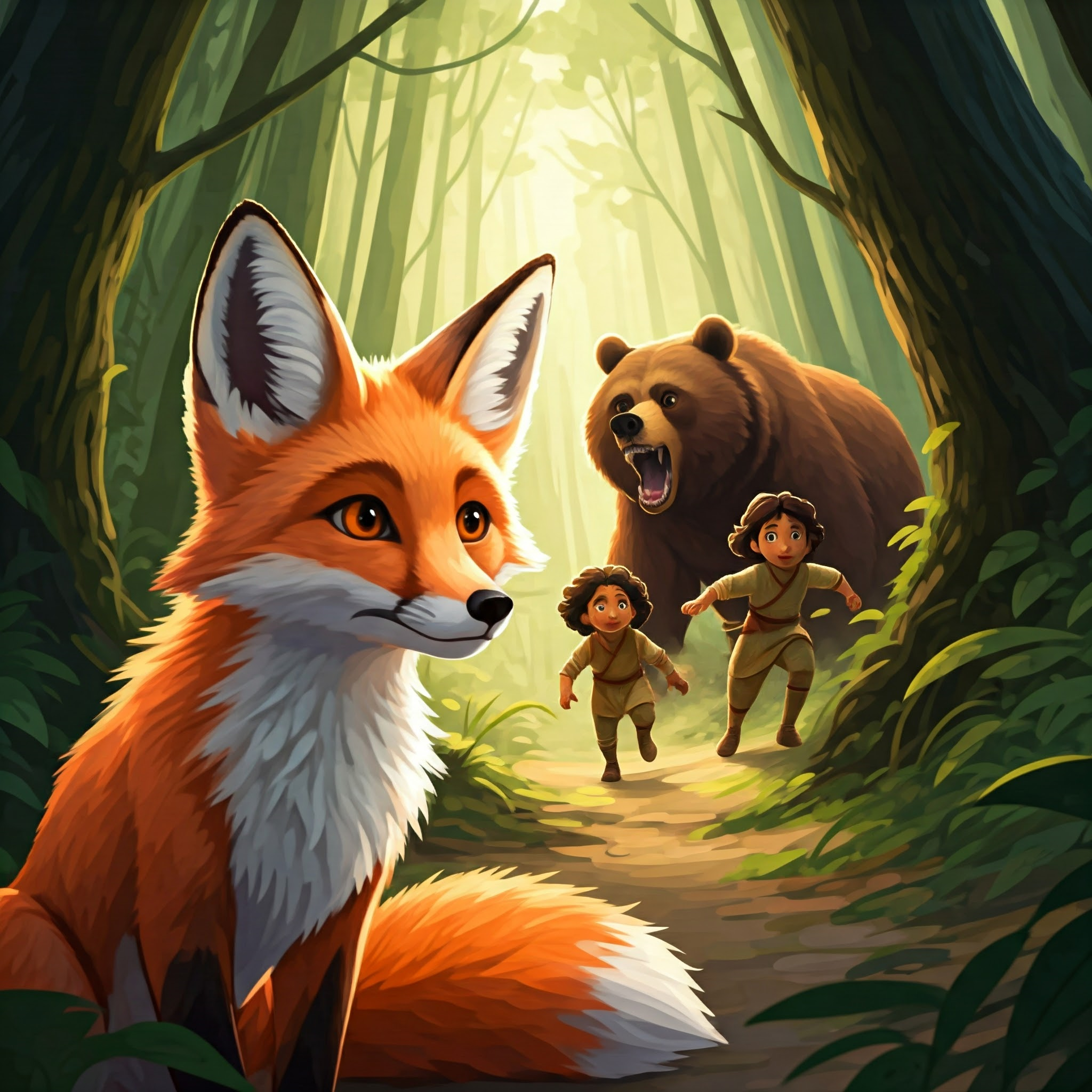
View Solution
The sketch portrays the bear chasing the kids, with the fox observing the scene. The forest background adds depth and context to the narrative.
Key elements include:
- The bear in the foreground.
- The kids running in panic.
- The fox watching from a perspective point.
- A detailed forest environment.
Question 1: SKETCHING
Two kids, Kaa and Kii, are on an adventure trip in a forest. While exploring, suddenly a bear emerges and starts chasing them. The kids start running in panic through the forest. A fox is watching the whole scene. Sketch this scene from the fox’s point of view.
Additional Instructions:
- Use only black/HB-series pencils.
- Do not use other colours.
- Draw only in the given space.
Evaluation Criteria:
- Character and expressions
- Proportion and composition
- Quality of sketching
- Environment and props

View Solution
The sketch portrays the scene from the fox’s perspective as it watches the kids running from the bear.
- The bear is shown in the foreground chasing the kids with expressions of fear on their faces.
- The fox is either in the background or slightly off to the side, observing the scene.
- The forest includes trees, bushes, and other elements that establish depth and context.
- Focus is on the dynamic movement and emotions of the characters.
Question 2: CREATIVITY
Shown below is a canvas with four frames containing certain elements. Create a meaningful sequence of visuals using the elements in the frames. Ensure continuity is maintained. You may choose to create the sequence either from left to right or right to left, but indicate the direction using an arrow. Give an appropriate title in the space provided.
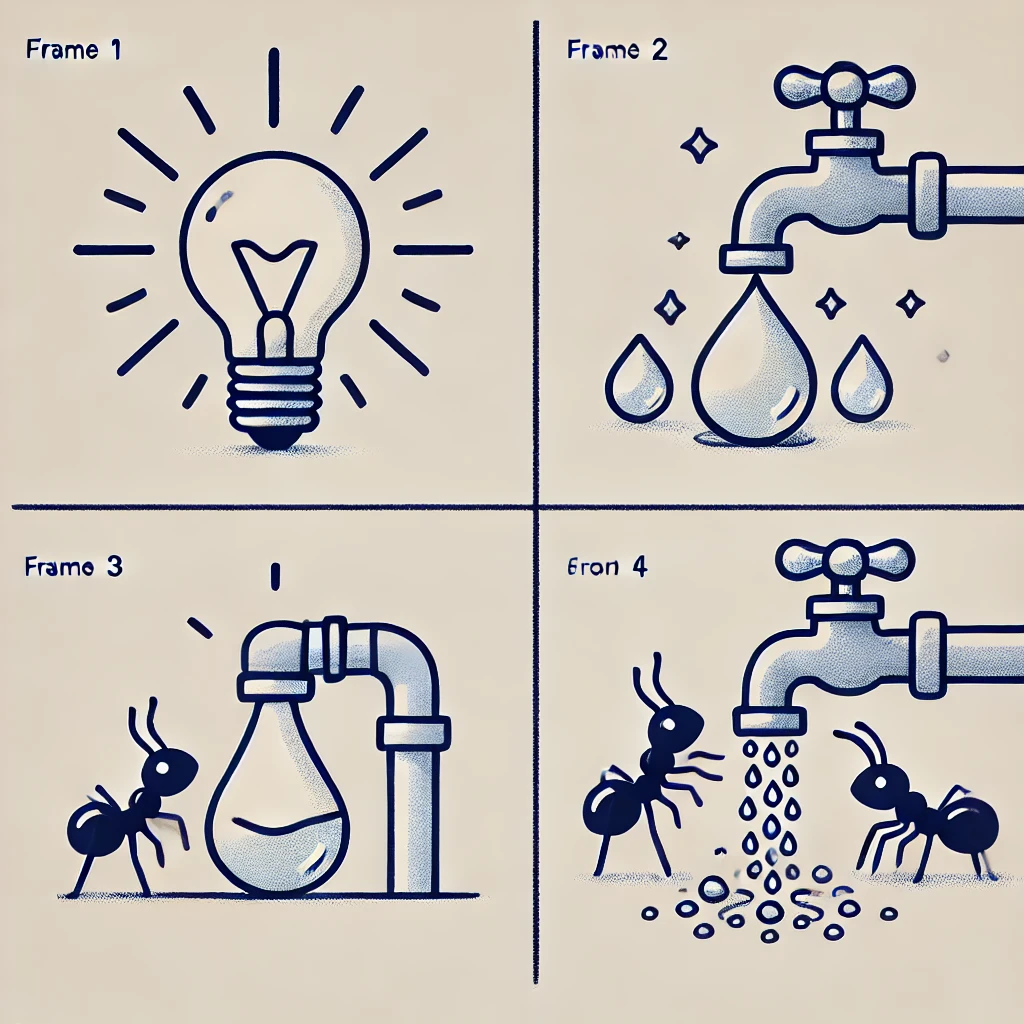
View Solution
Step 1: Imagine the sequence starting with the light bulb flickering, initiating a chain reaction.
Step 2: The faucet reacts to the bulb, eventually dripping and opening fully.
Step 3: Water flows out, but instead of water, a small insect emerges from the faucet.
Step 4: The insect appears in the last frame, completing the sequence.
Conclusion: The sequence portrays a creative and imaginative interaction between the objects.
Question 3: VISUAL SENSITIVITY
Shown below are new animals acquired by an Indian Zoo. The zoo wishes to create signage to guide visitors around the enclosures of these animals. Create four icons using only black colour to represent:
- Indian Grey Mongoose
- Honey Badger
- Indian Bison
- Indian Pangolin
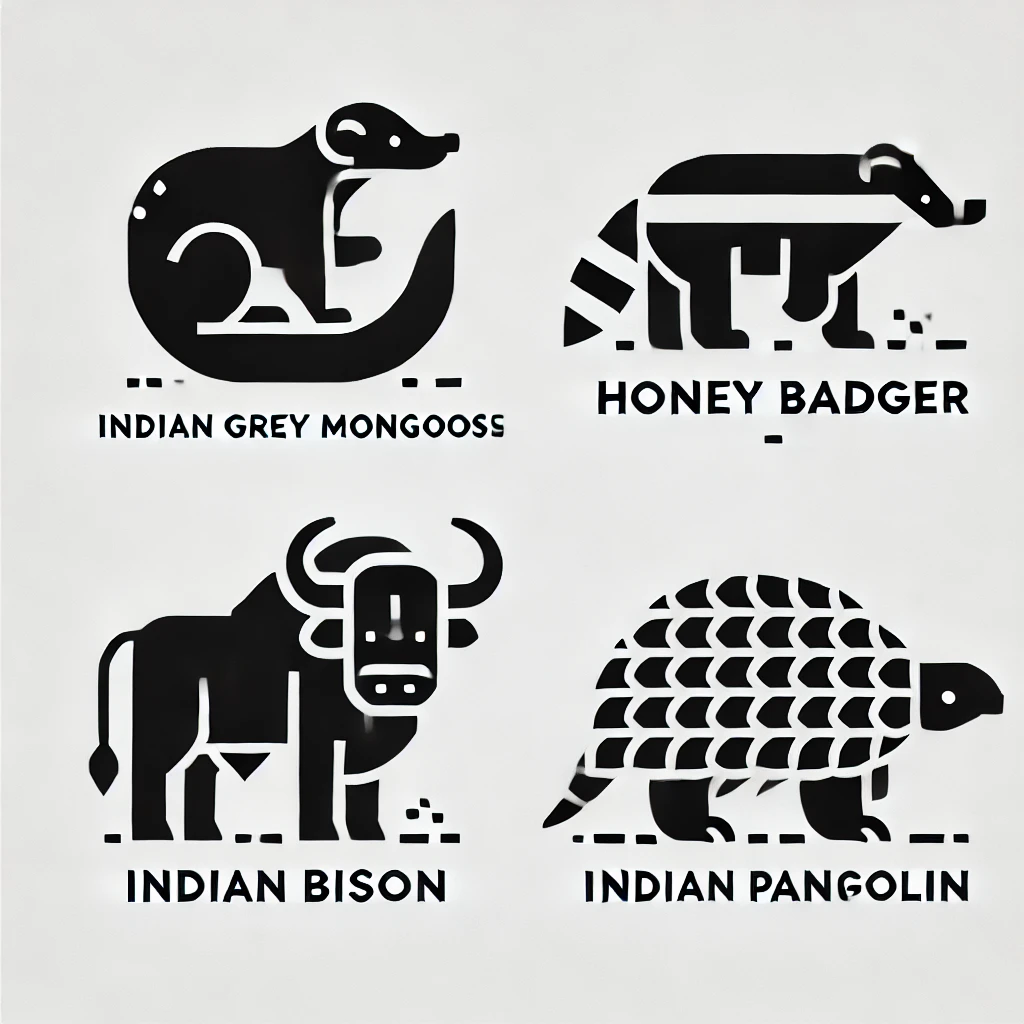
View Solution
The icons represent each animal:
- Indian Grey Mongoose: Slender body and characteristic curve.
- Honey Badger: Unique body shape and patterns.
- Indian Bison: Horns and robust frame.
- Indian Pangolin: Scaly structure simplified for clarity.
Question 4: FORM SENSITIVITY
Shown on the left is a character-based design of a product. Inspired by this product, re-imagine, conceptualize, and render the tea flask given on the right.
Evaluation Criteria:
- Characterization of the product
- Relevant details and usability
- Quality of sketching
- Surface shading/rendering
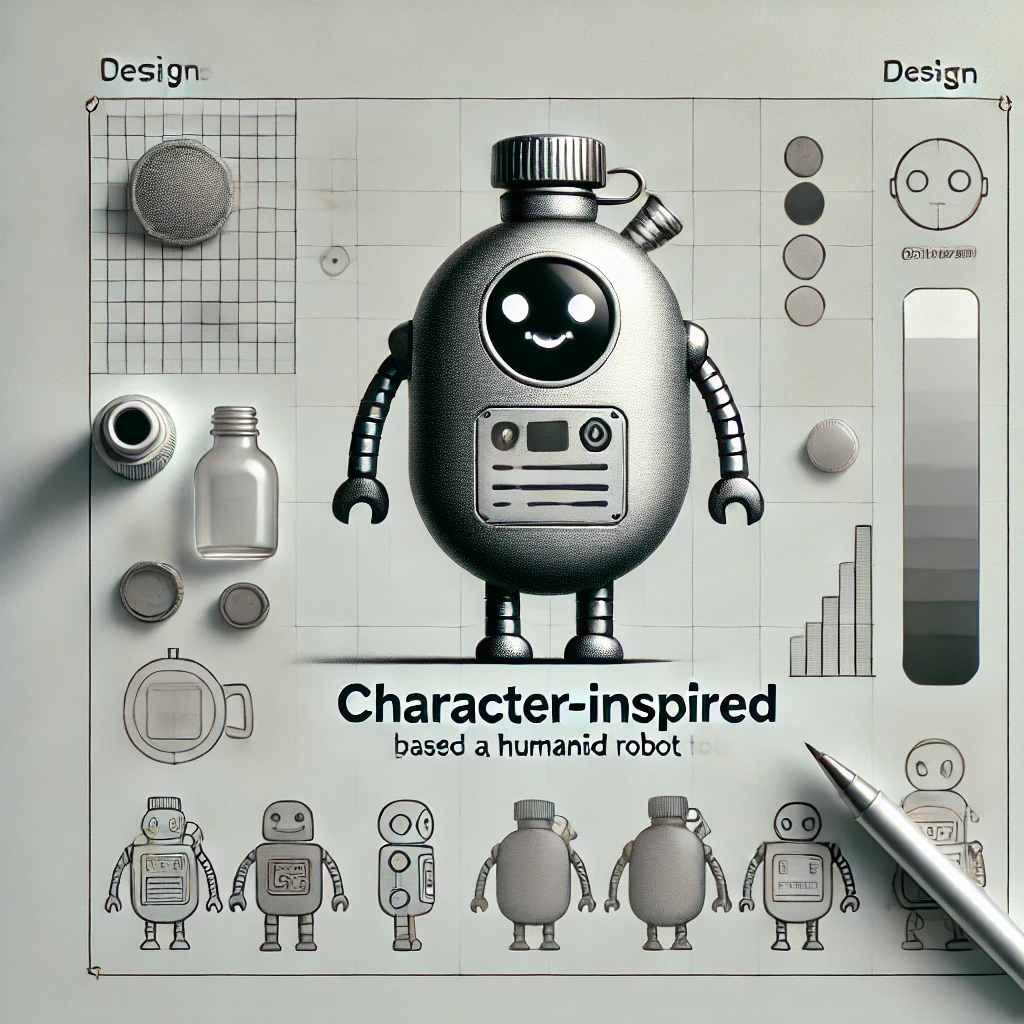
View Solution
The tea flask incorporates humanoid robotic features, blending functionality with creative aesthetics:
- Expressive eyes and articulated arms enhance its character.
- A metallic finish ensures durability and aesthetic appeal.
- Surface shading enhances the overall design and usability.
Question 5: PROBLEM IDENTIFICATION
A typical vegetable cart, as seen in India, is shown below:
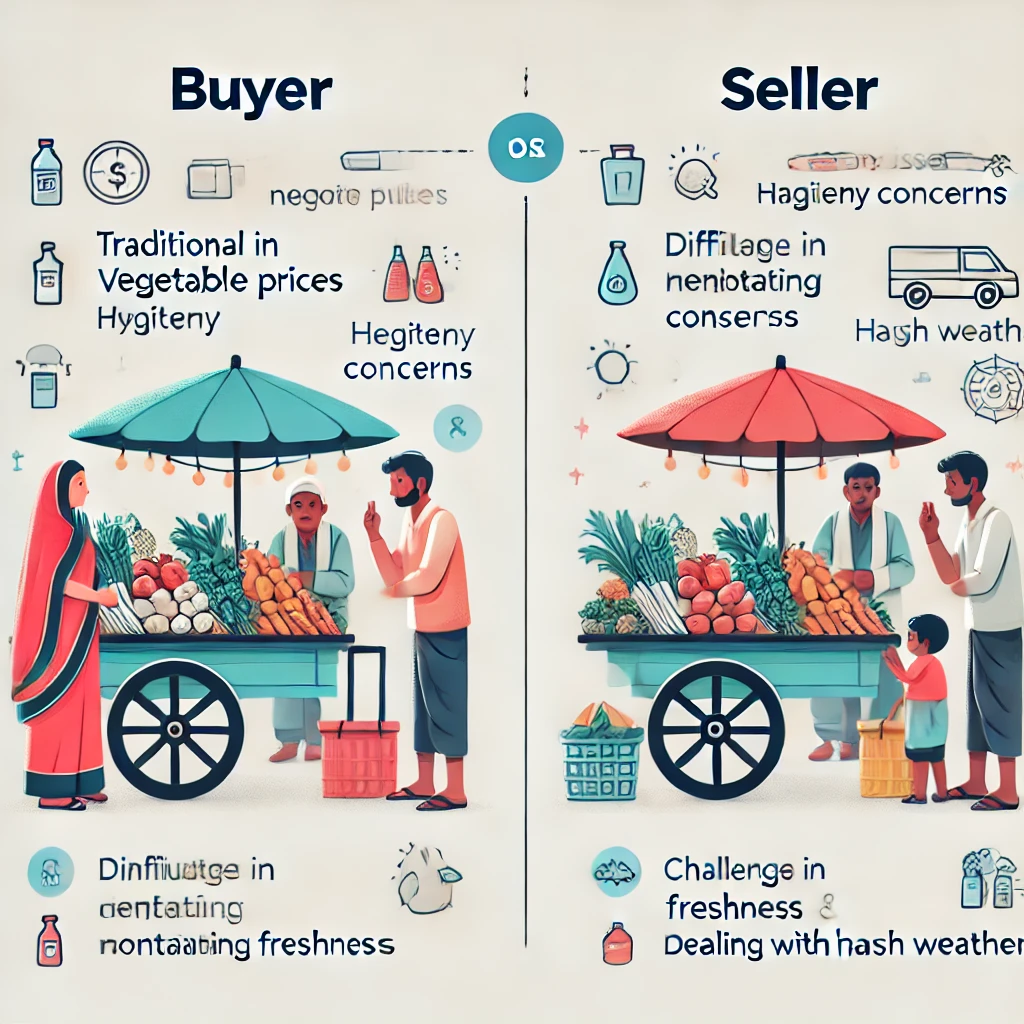
Tasks:
- (5 + 5 marks): Identify and list FIVE distinct problems from:
- Buyer’s Point of View
- Seller’s Point of View
- (5 + 5 marks): From the above-listed problems, draw and visually explain:
- ONE problem of the buyers.
- ONE problem of the sellers.
Additional Instructions:
- Do not limit yourself to the buyer and seller in the given image.
- Write the identified problems only on the dotted lines.
- Draw and visually explain the listed problems only in the given boxes.
Evaluation Criteria:
- Ability to identify unique and relevant problems in the given context.
- Severity of the problems identified.
- Ability to communicate problems through visuals.
- Presentation, clarity, and neatness.
View Solution
Identified Problems:
- Buyer’s Point of View:
- Difficulty in negotiating prices.
- Hygiene concerns due to open-air exposure.
- Limited payment options.
- Difficulty in carrying purchased items.
- Inconsistent vegetable quality.
- Seller’s Point of View:
- Challenges in maintaining freshness of vegetables.
- Exposure to harsh weather conditions.
- Difficulty in attracting new customers.
- High dependency on manual labor.
- Lack of infrastructure for better storage.
Visual Representation:

Explanation:
- Buyer Problem: Visual representation shows a buyer struggling to carry multiple bags, highlighting the need for ergonomic carrying solutions.
- Seller Problem: Visual representation depicts the seller covering vegetables with a cloth to prevent spoilage, indicating a lack of proper storage solutions.













Comments